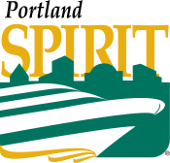Columbia Gorge Sternwheeler History
The Columbia Gorge Sternwheeler was built in Hood River, Oregon by Nichols Boat Works and was launched in 1983. On April 19, 2006, the Columbia Gorge Sternwheeler became the first and only paddle boat leased by American Waterways, Inc (dba Portland Spirit). The lease ended on December 31, 2022.
History of Cascade Locks & Sternwheelers
The history of Cascade Locks is intimately tied to the Columbia River. The small settlement that grew up on the banks of the river helped early travelers portage around the rapids, first by foot, then by mule-drawn rail cars, steam engines and finally riverboats.
In 1803, Meriwether Lewis and William Clark were commissioned by President Thomas Jefferson to learn and report about western geography, climate, plants and the indigenous people they encountered on their journey to find the great waterway to the Pacific Ocean. Lewis and Clark’s Corp of Discovery portaged around the Cascades Rapids in 1805. They wrote in their journal, “this great chute of falls is about 1/2 a mile with the water of this great river compressed within the space of 150 paces, great number of both large and small rocks, water passing with great velocity forming & boiling in a horrible manner, with a fall of about 20 feet (October 30- November 1, 1805).
 Forty years later, pioneers traveling the Oregon Trail’s water route were forced to make the same portage around the dangerous rapids. Travelers heading west had to make a crucial decision just upstream of these rapids at The Dalles, Oregon. They had to choose whether they would risk life and limb on Mt. Hood’s steep Barlow Road and overland toll route, or build a raft and float down the Columbia River, risking their life free of charge.
Forty years later, pioneers traveling the Oregon Trail’s water route were forced to make the same portage around the dangerous rapids. Travelers heading west had to make a crucial decision just upstream of these rapids at The Dalles, Oregon. They had to choose whether they would risk life and limb on Mt. Hood’s steep Barlow Road and overland toll route, or build a raft and float down the Columbia River, risking their life free of charge.
 The little Oregon Pony, the first steam engine west of the Mississippi River, carried passengers and freight past the rapids in 1864. Today, the engine can be viewed in Marine Park.
The little Oregon Pony, the first steam engine west of the Mississippi River, carried passengers and freight past the rapids in 1864. Today, the engine can be viewed in Marine Park.
In 1896, the navigational canal and locks at the site of the rapids were completed and modern-day Cascade Locks was born.

The locks allowed safer navigation of the river, and riverboat whistles echoed in the Gorge each day as the boats made their runs from Portland and The Dalles. Passengers still disembarked at Cascade Locks for portage around the rapids until 1938, when Bonneville Dam succeeded in completely taming the rapids.
Eventually, passengers and freight were drawn to more modern forms of transportation; roads and railroads displaced the sternwheelers.
Information and images acquired from portofcascadelocks.org.
